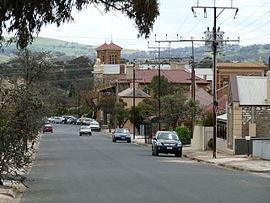Population 3,152 (2011 census) Postcode(s) 5373 Mean max temp Mean min temp Elevation 245 m Local time Friday 3:24 PM Federal division Division of Wakefield | Established 1839 State electorate(s) Stuart Founded 1839 Postal code 5373 | |
 | ||
Weather 33°C, Wind W at 14 km/h, 9% Humidity | ||
Kapunda is a town on the Light River and near the Barossa Valley in South Australia. It was established after a discovery in 1842 of significant copper deposits.
Contents
Map of Kapunda SA 5373, Australia
The southern entrance to the town has been dominated since 1988 by the 8-metre-tall statue of Map Kernow ("the son of Cornwall"), a traditional Cornish miner. The statue was destroyed by a fire on the morning of 1 June 2006 but has since been rebuilt by its creator, Ben van Zetten.
History
Francis Dutton and Charles Bagot, who both ran sheep in the area, discovered copper ore outcrops in 1842. They purchased 80 acres (32 ha) around the outcrop, beginning mining early in 1844 after good assay results. Mining began with the removal of surface ore and had progressed to underground mining by the end of the year. Copper was mined until 1879. There are also quarries near the town which provide fine marble ranging from dark blue to white. Marble from the Kapunda quarries was used to face Parliament House in Adelaide, and the pedestal of the statue of Venus on North Terrace, Adelaide is made of Sicilian and Kapunda marble.
A railway from Adelaide was opened in 1860, and extended to Eudunda and Morgan in 1878.
Kapunda had a strong Catholic community and Saint Mary MacKillop visited and established a convent there. St John's Reformatory for Girls operated from 1897 to 1909.
Kapunda is famous as the home of Sir Sidney Kidman. He was a major cattle pastoralist who at one time owned 68 properties with a total area larger than the British Isles. He held annual horse sales at Kapunda with up to 3,000 horses sold during the week. His house, Eringa, was donated to the Education Department, and is still used as the administration building for Kapunda High School. The town also has the unfortunate honour of being titled the most haunted town in Australia after a television documentary focused on the town. Most locals were not amused, however it has led to an increase in the amount of tourists that visit the area. Due to this, the ruins of the Reformatory, located outside the town, were bulldozed, although some locals still believe in the ghost stories popular in town. The town is also close to the historical Anlaby Station and the manor, houses, gardens and other buildings on the property, many of which are being restored by its current owners.
Kapunda was home to several notable manufacturers of farm and mining machinery: Robert Cameron, Joseph Mellors, James Rowe and Adamson Brothers. It was with this last-named company that T. J. Richards, the founder of one of Australia's largest coach-building firms, started his career.
Today, Kapunda is a producer of cereal crops, mainly wheat, barley and oats. Value-added services carried out by local industry include stock feed milling and hay processing. Kapunda is a contributor to the wine-growing industry centred in the nearby Barossa Valley.
Kapunda has hosted the Kapunda Celtic Music Festival since 1976.
Government
Kapunda is in the state electoral district of Stuart, the federal Division of Wakefield, and the centre of the Light Regional Council.
